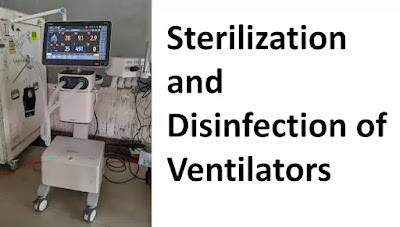Sterilization and Disinfection of Ventilators
 |
| Sterilization and Disinfection of Ventilators |
Sterilization and disinfection of ventilators are critical processes to ensure the safety of patients and healthcare workers. Proper cleaning and disinfection protocols are essential to prevent the spread of infections and maintain the optimal functioning of ventilators. The World Health Organization (WHO) provides guidelines based on the latest research to ensure effective sterilization and disinfection practices.
Differentiating Sterilization and Disinfection
Sterilization:
Sterilization is the process of completely eliminating all
microorganisms, including bacteria, viruses, and spores, from surfaces and
equipment.
It is typically achieved through methods like autoclaving
(steam under pressure), ethylene oxide gas, or hydrogen peroxide plasma
sterilization.
Reusable components that can withstand sterilization include
metal parts, certain sensors, and some connectors.
Disinfection:
Disinfection involves reducing the number of microorganisms
on surfaces to a safe level, eliminating most pathogenic organisms except
spores.
Ventilators are commonly subjected to high-level
disinfection methods due to the complexity of their components and the need to
prevent infection transmission.
High-touch surfaces, touch interfaces, and external panels
are among the components that require regular disinfection.
Reusable, Disposable, and Cleanable Components
Reusable Components:
Certain components of ventilators, such as metal parts, some
sensors, and connectors, are designed to withstand sterilization processes.
These reusable components should be carefully disassembled,
sterilized, and reassembled according to manufacturer guidelines.
Disposable Components:
Disposable components, including single-use filters,
breathing tubes, and some masks, are intended for one-time use.
Discard these components after each patient to prevent
cross-contamination and infection transmission.
Cleanable Components:
Components that are not suitable for sterilization or
disposables require thorough cleaning and high-level disinfection.
These components include control panels, touch interfaces,
external surfaces, and non-disposable tubing.
WHO Recommendations and Latest Research
Cleaning Before Disinfection:
WHO emphasizes the importance of thorough cleaning before
disinfection. Organic materials like dirt and body fluids can interfere with
the disinfection process.
Use neutral detergents and enzymatic cleaners to remove
debris without damaging sensitive components.
High-Level Disinfection:
High-level disinfection is recommended for ventilators,
particularly those that come into contact with mucous membranes or respiratory
secretions.
Use chemical disinfectants with proven efficacy against a
broad spectrum of pathogens.
Alcohol-Based Disinfectants:
Alcohol-based disinfectants with a concentration of at least
70% are effective against a wide range of microorganisms.
Wipe down external surfaces, control panels, and touch
interfaces with alcohol-based wipes.
Manufacturer's Recommendations:
Always follow the manufacturer's recommendations for
disinfection methods, agents, and frequency.
Deviating from these recommendations can risk damaging the
equipment or compromising patient safety.
UV-C Light Disinfection:
Some research suggests the potential use of UV-C light for
surface disinfection of ventilators.
UV-C light effectively inactivates microorganisms but should
be used cautiously to prevent harm to users and patients.
Regular Monitoring and Training:
Implement regular training sessions for healthcare staff on
proper disinfection techniques.
Continuously monitor adherence to protocols to ensure
consistent disinfection practices.
Commonly Used Detergents in India
CliniMax by Reckitt Benckiser:
CliniMax is an enzymatic detergent that is effective in
removing organic residues from medical equipment.
It is commonly used in healthcare facilities for cleaning
sensitive instruments and surfaces.
Hydrogen Peroxide Solutions:
Hydrogen peroxide solutions, at appropriate concentrations,
can be used for cleaning and disinfection of ventilator surfaces.
Manufacturer recommendations should be followed for proper usage.
Sterilization and disinfection of ventilators involve the
care of reusable components, proper disposal of disposable components, and
thorough cleaning of cleanable components. Following WHO recommendations and
staying updated with the latest research ensures that effective sterilization
and disinfection protocols are in place. Proper care and disinfection
contribute to the optimal functioning of ventilators, safeguarding the health
of patients and healthcare personnel.
Recommended Topics
Label List
- BASIC CONCEPTS (19)
- ANESTHESIA EQUIPMENTS (18)
- Exam (13)
- study material (12)
- MCQ FOR OT TECHNICIANS (11)
- ANESTHESIA PREPRATION (10)
- DEVICES USED IN OT (7)
- random topics (7)
- CSSD & OTHER DEVICES (6)
- FIND A JOB (5)
- QUESTION PAPERS (5)
- latest updates (4)
- DRUGS (3)
- PATIENT CARE (3)
- Registration (3)
- Surgical Instruments (3)
- History of Anesthesia (2)
- by - Ritika Sharma (1)

Post a Comment
Post a Comment